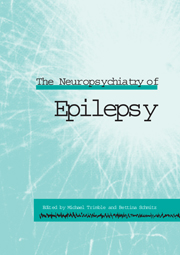Book contents
- Frontmatter
- Contents
- List of contributors
- Part I Background
- Part II Clinical aspects
- Part III Cognitive aspects
- Part IV Nonepileptic attacks
- Part V Treatment complications
- 16 The effects if antiepileptic drugs on behaviour
- 17 Antiepileptic drug treatment and epileptic seizures – effects on cognitive function
- 18 Psychiatric effects of surgery for temporal lobe epilepsy
- 19 Vagus nerve stimulation and mood
- Part VI Treatment
- Index
16 - The effects if antiepileptic drugs on behaviour
Published online by Cambridge University Press: 05 October 2010
- Frontmatter
- Contents
- List of contributors
- Part I Background
- Part II Clinical aspects
- Part III Cognitive aspects
- Part IV Nonepileptic attacks
- Part V Treatment complications
- 16 The effects if antiepileptic drugs on behaviour
- 17 Antiepileptic drug treatment and epileptic seizures – effects on cognitive function
- 18 Psychiatric effects of surgery for temporal lobe epilepsy
- 19 Vagus nerve stimulation and mood
- Part VI Treatment
- Index
Summary
Introduction
All antiepileptic drugs (AEDs) may have effects on thinking, mood and behaviour in individual patients. These psychotropic effects are not simply idiosyncratic but depend on the drug's anticonvulsive strength and the person's biological and psychological predisposition.
If a psychiatric disorder occurs in a patient with epilepsy this always has a multifactorial aetiology, anticonvulsant pharmacotherapy being only one of many risk factors. Because of the complex pathogenesis of psychiatric complications in epilepsy, aetiology-related epidemiological data are difficult to obtain, particularly since chronic effects of anticonvulsants are almost impossible to identify. Among a series of consecutive patients who developed either a schizophreniform psychosis or a major depression, peri-ictal syndromes predominated in psychotic patients, and interictal syndromes in depressed patients (Schmitz et al., 1999). Twenty-eight per cent of depressive episodes and 15% of psychotic episodes were attributed to drug treatment, including alternatives syndromes, intoxication and withdrawl syndromes. However, these figures may not be representative for today's praxis because the cases were largely collected prior to the introduction of new AEDs.
In a more recent series from Japan, the percentage of AED-related psychoses was significantly higher; 40% of unselected cases had psychoses following a change of their AED regime (half of which occurred with the new anticonvulsant zonisamide, which is not as yet licensed in Europe (Matsuura, 1999)).
The psychotropic effects of AEDs can be broken down into those which are negative and those which are positive or prophylactic.
- Type
- Chapter
- Information
- The Neuropsychiatry of Epilepsy , pp. 241 - 255Publisher: Cambridge University PressPrint publication year: 2002
- 4
- Cited by



